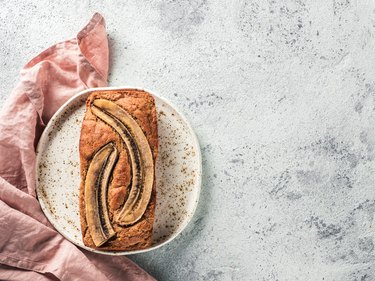
Anticipating a light, fluffy loaf, but ending up with banana bread that doesn't rise is a deflating experience. There are a couple common explanations: There's a problem with your leavening agent, or the bread isn't cooked properly. Solving these problems will lift your bread and your spirits.
Check the Leavening Agent
Video of the Day
Banana bread recipes all use some sort of leavening agent. For quick breads, such as banana bread and cornbread, this is typically baking powder or baking soda or both, notes the University of Kentucky Cooperative Extension Service. These are required to make the bread rise.
Video of the Day
What many bakers don't realize is that leavening agents can expire and become inactive. If you've had your packages of baking soda and baking powder in the cupboard since you can't remember when, this could be the explanation for why your banana bread doesn't rise.
According to Quaker Oats, leavening agents should be discarded after six months. Most packaging has an expiration date, so be sure to check it before using. If the expiration date has passed, you can perform a simple test to see whether baking soda and baking powder are still OK to use.
Michigan State University Extension recommends testing baking powder by placing 1/2 teaspoon in a bowl and pouring 1/3 cup of warm water on top of it. The mixture should start noticeably bubbling.
To test baking soda, mix 1 1/2 teaspoons with 1 tablespoon of vinegar. You should see significant bubbling. If either mixture doesn't bubble, the leavening agent is inactive and should be tossed.
It might not be the age of your leavening agent but the amount you use. Using too much or too little baking powder or baking soda in proportion to the other ingredients in your recipe could be the reason your banana bread collapses when cooling.
To measure correctly, Quaker Oats recommends spooning the powder into the measuring spoon instead of scooping it. Then, take a knife and level the powder even with the rim of the measuring spoon.
Make Sure It's Cooked Properly
Leavening agents create air bubbles in the batter, which is what causes the bread to rise. Baking sets these air bubbles so they remain in the finished product. But if the banana bread is not done in the middle, the structure doesn't set properly. That's often why banana bread collapses when cooling.
To avoid banana bread that's not done in the middle, King Arthur Flour offers these tips:
- Calibrate your oven. Oven temperatures vary and may be off by 10, 20, 30 degrees or more. Always use a standalone oven thermometer set on a rack inside your oven. You can even use two so you can check them against each other.
- Preheat your oven properly. Your oven may be lying when it says it's reached the correct temperature. Use your portable oven thermometer to ensure the correct temperature before you put in your pan of batter.
- Position the pan correctly. Place the pan in the exact center of the rack to ensure even cooking. You may also need to raise your oven rack to get the bread closer to the heating element — about 6 inches from the heating element to the top of the pan is an optimal distance. To prevent the top from burning, tent a piece of tin foil over the pan for the last third of the baking time.
- Use a digital thermometer to test doneness. Inserting a toothpick into the center to see if it comes out clean may not get an accurate result with textured breads containing bits of fruit. For a more accurate reading, insert a digital thermometer into the exact center all the way down to the bottom of the pan, then withdraw it slowly. In the center of the bread, the temperature should read 200 to 205 degrees Fahrenheit. Anything below 200 degrees means your banana bread didn't cook in the middle.